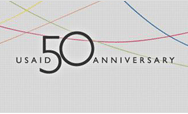USAID History
On Nov. 3, 1961, President John F. Kennedy established the U.S. Agency for International Development (USAID). It was the first U.S. foreign assistance organization whose primary emphasis was on long-range economic and social development assistance to foreign countries. Though this new agency was born during a time of social, political and economic upheaval around the globe, USAID's origins were planted shortly after World War II ended in 1945.
Much of the United States' modern-day international development assistance evolved out of Secretary of State George C. Marshall's plan to commit significant U.S. resources as a way of responding to calls to rebuild Europe's infrastructure and economy at the end of the Second World War. In what would come to be known as the Marshall Plan, the United States helped stabilize a post-war Europe by providing financial and technical assistance through the European Recovery Act of 1947.
|
In his formation of USAID, President John F. Kennedy was blunt in his assessment of the current state of foreign assistance; his desire for a muscular agency to stand behind U.S. efforts to promote peace and prosperity; and his fears of the consequences of inaction.
“For no objective supporter of foreign aid can be satisfied with the existing program – actually a multiplicity of programs,” Kennedy said. “Bureaucratically fragmented, awkward and slow, its administration is diffused over a haphazard and irrational structure covering at least four departments and several other agencies. The program is based on a series of legislative measures and administrative procedures conceived at different times and for different purposes, many of them now obsolete, inconsistent, and unduly rigid and thus unsuited for our present needs and purposes. Its weaknesses have begun to undermine confidence in our effort both here and abroad.
“… There is no escaping our obligations: our moral obligations as a wise leader and good neighbor in the interdependent community of free nations – our economic obligations as the wealthiest people in a world of largely poor people, as a nation no longer dependent upon the loans from abroad that once helped us develop our own economy – and our political obligations as the single largest counter to the adversaries of freedom.
“To fail to meet those obligations now would be disastrous; and, in the long run, more expensive. For widespread poverty and chaos lead to a collapse of existing political and social structures which would inevitably invite the advance of totalitarianism into every weak and unstable area. Thus our own security would be endangered and our prosperity imperiled. A program of assistance to the underdeveloped nations must continue because the Nation's interest and the cause of political freedom require it.” |
Point Four
Building on the success of the Marshall Plan, President Harry S. Truman proposed an international development assistance program in his 1949 inaugural address. The 1950 Point Four Program focused on two goals: creating markets for the United States by reducing poverty and increasing production in developing countries, and diminishing the threat of communism by helping countries prosper under capitalism.
From 1952 to 1961, programs supporting technical assistance and capital projects continued as the primary form of U.S. aid, and were recognized as a key component of U.S. foreign policy. During this time, government leaders established various precursor organizations to USAID: the Mutual Security Agency, the Foreign Operations Administration and the International Cooperation Administration.
An Agency is born
On Sept. 4, 1961, at Kennedy's urging, Congress passed the Foreign Assistance Act, which mandated the creation of an agency to promote long-term assistance for economic and social development.
From the “decade of development” to basic human needs
On the heels of USAID's inception, the years of the Kennedy and Johnson administrations were known as the “decade of development” and were a time of tremendous growth in international development assistance.
The 1970s were marked by a significant departure in the delivery of U.S. development assistance. A “basic human needs” approach replaced technical and capital assistance programs, and stressed a focus on food and nutrition; population planning; and health, education and human resources development.
A turn to free markets
In the 1980s, foreign assistance turned to stabilization and restructuring. USAID designed export-oriented production and trade projects to stabilize currencies and financial systems. It also promoted market-based principles to restructure developing countries' policies and institutions. During this decade, USAID reaffirmed its commitment to broad-based economic growth, emphasizing employment and income for poor people through a revitalization of agriculture and expansion of domestic markets. In this decade, development activities were increasingly channeled through private voluntary organizations (PVOs), and aid shifted from individual projects to large programs comprising a number of projects.
Sustainability and democracy
In the 1990s, “sustainable development” was the priority, and USAID concentrated on programs that capitalized on the ability of a country to improve its own quality of life. During this decade, development assistance programs also were packaged according to a country's economic condition: developing countries received an integrated package of assistance, while transitional countries received help in times of crisis. Countries with limited USAID presence received support through nongovernmental organizations, or NGOs. The fall of the Berlin Wall in 1989 brought new development challenges, and USAID played a lead role in planning and implementing programs to establish functioning democracies with open, market-oriented economic systems and responsive social safety nets.
War and rebuilding
The 2000s, brought more evolution for USAID and foreign assistance with government officials once again calling for reform of how the agency conducts business. With the Afghanistan and Iraq wars in full swing, USAID was called on to help those two countries rebuild government, infrastructure, civil society and basic services such as health care and education. The Agency began rebuilding with an eye to getting the most bang out of its funding allocations. It also began an aggressive campaign to reach out to new partner organizations – including the private sector and foundations – to extend the reach of foreign assistance.
Today, USAID staff work in more than 100 countries around the world with the same overarching goals that President Kennedy outlined 50 years ago – furthering America's foreign policy interests in expanding democracy and free markets while also extending a helping hand to people struggling to make a better life, recover from a disaster or striving to live in a free and democratic country. It is this caring that stands as a hallmark of the United States around the world.
Back to Top ^
|




